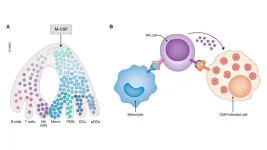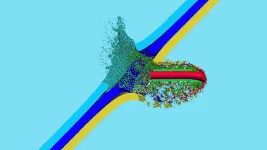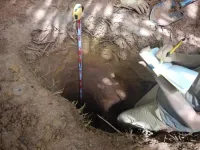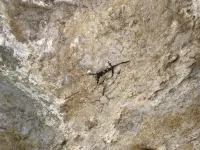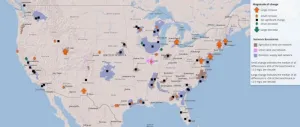(Press-News.org) Scientists measured microplastic concentrations in the highly productive Barents Sea and suggest that ocean circulation, ice melt, tourism, inadequate waste management, shipping and fishing are all likely contributors.
Numerous studies have shown that global microplastic quantities in the marine environment are increasing, even in remote locations such as the Arctic.
The Barents Sea, which adjoins the Arctic Ocean, is one of the most productive oceanic areas in the world and home to an enormous diversity of organisms.
It is also a key route for Atlantic water flow into the Arctic Ocean and has been earmarked as a potential microplastic hotspot.
A new study, by scientists from Plymouth Marine Laboratory and the University of Exeter, explored large volume samples of sub-surface water collected from transects through the Barents Sea to quantify, characterise and determine distribution of microplastics in this region, with a focus on potential impacts to zooplankton.
Given that the Barents Sea is an area of high primary productivity and the size of microplastics overlapping with optimal prey size of zooplankton, it is considered likely that zooplankton within this region will be consuming microplastics, facilitating the entry of these anthropogenic particles into polar food webs.
Previous studies have shown that the ingestion of microplastic by zooplankton can negatively affect fertility and growth as well as alter the sinking velocity of their faeces; an important process that assists the transport of carbon and nutrients to deeper waters and the seabed.
Overall, the mean microplastic quantity in the eastern Barents Sea was 0.011 microplastics per cubic metre (range: 0.007 – 0.015 m-3).
Microplastics were found in higher abundances nearer land mass at the southern end of the transect and northwards towards the ice edge, recording 0.015 microplastics m-3 during both transect legs.
Microplastics were predominantly fibrous (92.1%) and typically blue (79%) or red (17%) in colour.
A range of polymers were identified including polyester (3.8%), copolymer blends (2.7%), elastomers (7.1%) and acrylics (10.6%), with the vast majority observed from anthropogenically modified cellulose, such as rayon.
The study concludes that while it is not possible to determine the source of the plastic through this study, the highest concentrations were found close to sources of anthropogenic pollution and ice melt, which are known repositories of marine microplastic.
The possibility of local input is also likely; as tourism in Svalbard continues to increase, the lack of adequate waste infrastructure will result in increased leakage into the surrounding waters.
Increased tourism, paired with other local sources including wastewater input, shipping activities and fishing, could explain the higher levels of microplastic abundance towards the coastline compared to further offshore.
Heather Emberson-Marl, lead author on the paper and MSc student with the University of Exeter and Plymouth Marine Laboratory, said: “It is apparent that microplastic data from the Arctic is limited and this study will act as a reference point for further research.
“Additionally, sampling methods between studies of microplastics within the Arctic vary and the differing units of measurement used in previous research make it difficult to draw comparisons.
“We recommend that future studies should strive for a standardised sampling protocol to allow for direct comparisons and more robust conclusions on the ecological and toxicological effects on the Arctic’s marine biology.”
Dr Rachel Coppock, Marine Ecologist at Plymouth Marine Laboratory and co-author on the study, commented: “The Arctic region is remote and most of us might imagine that it is a pristine natural wonder.
“But once microplastics enter the marine environment they are transported on currents, often from populated areas many thousands of miles away, ending up far from the source and in the case of the high Arctic, may become trapped in sea ice and released during the spring melt.
“Warming seas are causing greater sea ice melt, potentially releasing further microplastics and adding another layer of complexity to marine life adapting to a changing world.”
This study was partly funded by the UK’s Natural Environment Research Council (NERC) through the GW4+ internship and the Changing Arctic Ocean Sediments grant.
END
Ocean circulation, ice melt and increasing tourism could all be contributing to Arctic microplastics
2023-10-17
ELSE PRESS RELEASES FROM THIS DATE:
Boosting weak immune system: scientists find an unusual weapon against virus
2023-10-17
Some viruses can be dormant throughout a person’s life and cause no harm but become dangerous when the immune system is weakened. One of such viruses is human cytomegalovirus (CMV). Harmless to the general public but life-threatening to patients with a supressed immune system.
“Patients undergoing bone marrow transplantations have their blood and immune system fully replaced by that of the donor. In the first months after transplantation they are defenseless. They can either catch CMV or have virus reactivated that was dormant in the patient. At the moment, there is no ideal treatment. The available ones work ...
Depression, anxiety common among college students
2023-10-17
Depression and anxiety among college students is a growing public health problem. And new research from the University of Georgia suggests the problem may be worse for students who aren’t the same race as most of their peers.
The new study found that students who were not the majority race at a predominantly white college reported significantly higher rates of depression than their white peers.
At the mostly white university, more than half of the students who self-identified as races other than white reported feelings of mild depression. An additional 17% said they were experiencing moderate to severe depression.
Students at the predominantly ...
Research finds water quality in Gulf of Mexico improves when adding social costs to carbon emissions
2023-10-17
DURHAM, N.H.—U.S. Climate policies can offer options for putting climate change efforts into place that solve environmental problems like excessive carbon dioxide in the atmosphere created by greenhouse gas emissions. Research led by the University of New Hampshire took a closer look at what would happen to agriculture if there was an extra cost, or so-called social cost, added to fossil fuels, which are essential for making fertilizer used in farming. They found that while CO2 emissions would decline by as much as 50%, the cost of fertilizer would rise leading to a significant benefit on water quality by lessening fertilizer runoff contributing ...
Mitigating electrode-level heterogeneity using phosphorus nanolayers on graphite for fast-charging batteries
2023-10-17
In a major stride towards achieving fast-charging lithium-ion batteries (LIBs) with reliable cyclability, researchers at UNIST have made a groundbreaking discovery. Their study, published in the prestigious ACS Energy Letters, introduces a novel strategy of utilizing phosphorus nanolayers to enhance the lithiation kinetics and performance of graphite-based composites, without compromising safety.
Led by Professor Hyun-Wook Lee from the School of Energy and Chemical Engineering at UNIST, the research team developed a revolutionary graphite-phosphorus composite using a vaporization-condensation ...
In 2020, 30% of the Pantanal was burned to cinders by wildfires
2023-10-17
In 2020, the Pantanal, the largest tropical freshwater wetland in the world and a biodiversity hotspot, was swept by high-intensity fires that destroyed native vegetation in an area totaling 44,998 square kilometers (km²), or about 30% of the Brazilian portion of the biome, which spans some 150,000 km². The estimate is presented in an article published in the science journal Fire.
The area destroyed by that year’s disastrous fires was far larger than had been thought, according to the article. ...
SwRI will advance impact modeling software for U.S. Army Corps of Engineers
2023-10-17
SAN ANTONIO — October 17, 2023 —Southwest Research Institute (SwRI) will continue advancing the Elastic Plastic Impact Computations (EPIC) dynamic finite-element code as part of an Other Transaction Prototype Agreement with the U.S Army Corps of Engineers. The first year’s funding of $500,000 has been awarded, with optional additional funding across the next three years totaling $3.5 million.
“EPIC uses finite element and particle methods to simulate complex impact and explosion scenarios,” said SwRI Staff Engineer Dr. Stephen Beissel, who leads the EPIC project and has been involved in EPIC’s development since the mid-1990s. ...
The earthworm effect: unraveling soil weathering dynamics
2023-10-17
17 October 2023
The Geological Society of America
Release No. 23-42
Contact: Justin Samuel
+1-303-357-1026
jsamuel@geosociety.org
For Immediate Release
Contributed by Sarah Derouin
Pittsburgh, Pa., USA: Earthworms, the hardworking invertebrates that grace the upper layers of soil, have long been considered helpful in our home gardens. Earthworms are prolific munchers, grinding up organic material and sediment grains that make up soils. Although they are very different animals, worms, like many poultry, have gizzards. “Worms will ingest some larger soil grains, and then they use the strongest and largest of those grains, retaining them in their gizzard,” ...
New dating of cave art reveals history of Puerto Rican people
2023-10-17
17 October 2023
The Geological Society of America
Release No. 23-40
Contact: Justin Samuel
+1-303-357-1026
jsamuel@geosociety.org
For Immediate Release
Leer en español.
Contributed by Sarah Derouin
Pittsburgh, Pa., USA: In the karstic caves of Puerto Rico, cave art paints the rock walls. Previous research has assigned ages to this art based on the ages of nearby archaeological artifacts within the caves, but these ages are relative and may not reflect the true timing of the art creation.
Now, a new study to be presented Wednesday at the Geological Society of America’s GSA Connects 2023 meeting shows that researchers have refined the age of this rupestrian ...
U.S. groundwater is getting saltier—what that means for infrastructure, ecosystems, and human health
2023-10-17
17 October 2023
The Geological Society of America
Release No. 23-41
Contact: Justin Samuel
+1-303-357-1026
jsamuel@geosociety.org
For Immediate Release
Contributed by Sarah Derouin
Pittsburgh, Pa., USA: Scientists from the U.S. Geological Survey (USGS) have been monitoring groundwater quality in wells across the country for more than three decades, looking for harmful chemicals or residual substances that may cause harm to ecosystems or humans. In all, they have measured up to 500 chemical constituents, including major ions, metals, pesticides, volatile organic compounds, fertilizers, and radionuclides.
Of ...
Pathogen that plagues food processing plants eradicated by blue light
2023-10-17
Washington, D.C. – Blue light kills both dried cells and biofilms of the pathogen Listeria monocytogenes, a frequent contaminant of food processing facilities. Demise of L. monocytogenes occurred quickest when cells or biofilms were placed on polystyrene, a widely used, transparent form of plastic. The research is published in Applied and Environmental Microbiology, a journal of the American Society for Microbiology.
“These results contribute to advancing our understanding of the potential of blue light to treat inert surfaces contaminated with L. monocytogenes,” said corresponding author ...
